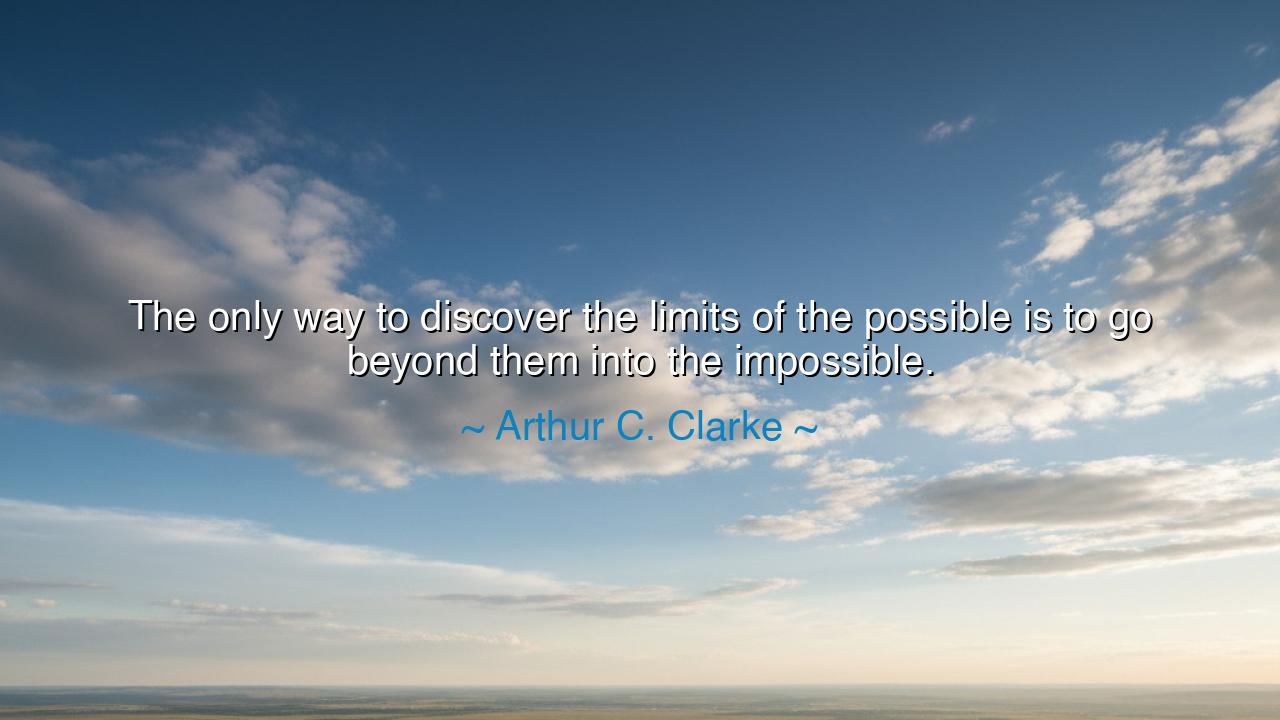
The only way to discover the limits of the possible is to go
The only way to discover the limits of the possible is to go beyond them into the impossible.






“The only way to discover the limits of the possible is to go beyond them into the impossible.” — so declared Arthur C. Clarke, the great visionary of the modern age, whose imagination bridged the chasm between science and wonder. In these words lies the pulse of all human progress, the secret fire that has carried our species from the caves of darkness to the stars above. Clarke speaks not only of invention, but of the eternal spirit of exploration — that sacred daring which refuses to accept the boundaries of the known. To truly know what is possible, one must first have the courage to walk through the veil of the impossible.
In the ancient manner of wisdom, this saying is not merely about achievement — it is about faith. For to go beyond the limits of the possible is to step into mystery, to trust in vision more than sight, and to act even when success is uncertain. The impossible is not a wall but a doorway, hidden until the brave attempt to cross it. Every truth once stood as madness; every invention was once a dream. Fire was once forbidden to mortals, flight was once fantasy, the stars were once unreachable. Yet, through the ages, the human spirit has shattered every barrier that dared to confine it.
Clarke himself knew this truth well. As a writer and scientist, he dreamed of technologies and worlds that others called impossible. Long before the first satellite orbited the Earth, Clarke envisioned the concept of geostationary communication satellites, foreseeing the network that would one day connect all nations. What was then mere imagination became the very foundation of modern communication — proof that today’s impossibility is tomorrow’s reality. His words are not a metaphor alone, but a law of creation: that the frontier of possibility expands only when the human will dares to trespass upon it.
History too is rich with those who have lived this truth. Think of the Wright brothers, two men of humble means who refused to believe that man was earthbound. The world laughed at their dream of flight; scholars declared it a violation of nature. Yet they persisted, guided by vision, not validation. In a field of wind and dust at Kitty Hawk, they broke through the limits of the possible — and the sky became humanity’s second home. From their fragile wings came the roaring engines of progress, the age of air, and even the reach for space. Thus, their courage revealed what Clarke would later articulate: to go beyond the impossible is to redefine what humanity can become.
But Clarke’s teaching extends beyond science and invention; it touches the heart of life itself. Every soul has its own boundaries — fears, doubts, and the invisible walls built by experience or pain. To go beyond them is to awaken one’s true potential. The artist who paints beyond convention, the leader who stands against despair, the healer who serves in hopeless places — all discover the same truth: that greatness lies not in safety, but in transcendence. To step beyond comfort, to dream beyond reason, is to touch the divine rhythm of creation itself.
And yet, this path is not easy. The world will always warn the dreamer to stay within bounds. “Be realistic,” it whispers, “Do not reach too far.” But the wise know that “realistic” is merely another word for fear. The ancients understood that the gods favor the bold — that courage is the bridge between man and destiny. To attempt the impossible is to live fully; to stay within the possible is to wither unseen. The flame of progress burns only where the wind of risk blows.
So, my child, heed this teaching of Arthur C. Clarke: Do not be content with the limits you see. They are not prisons, but challenges. In your work, your art, your love, and your dreams — reach beyond. When you hear the voice that says, “It cannot be done,” let that be the signal that it must be attempted. For even if you fail, you will not return empty-handed; you will have stretched the horizon of the human spirit. And perhaps, in your daring, others will find the courage to follow.
For in the end, this is the legacy of all who have ever changed the world: they refused to stop at the edges of the known. They looked into the night and said, “There must be more,” and in saying so, they made it so. The only way to discover the limits of the possible is to go beyond them into the impossible. Go, then — and be one of those who discover.






AAdministratorAdministrator
Welcome, honored guests. Please leave a comment, we will respond soon